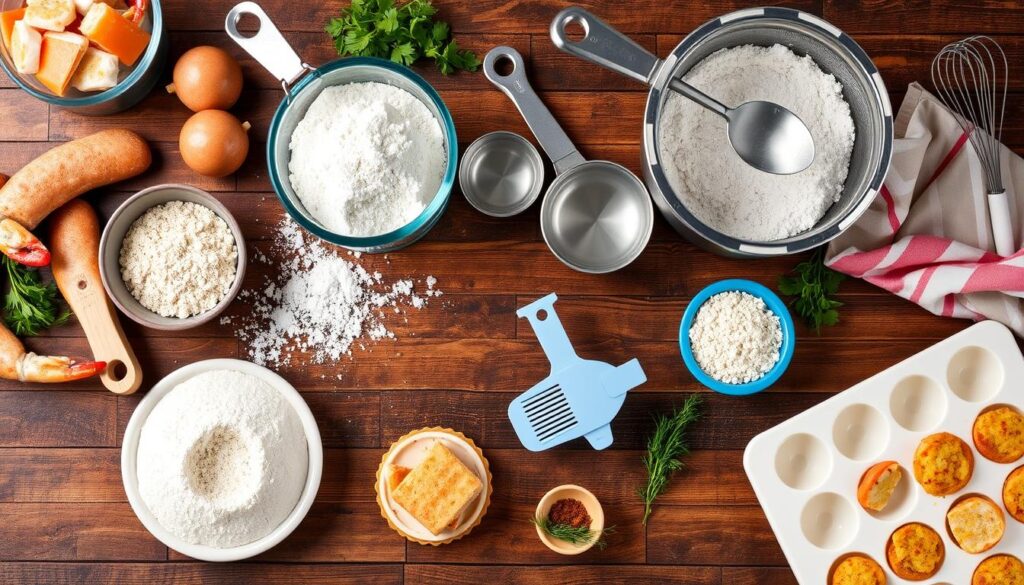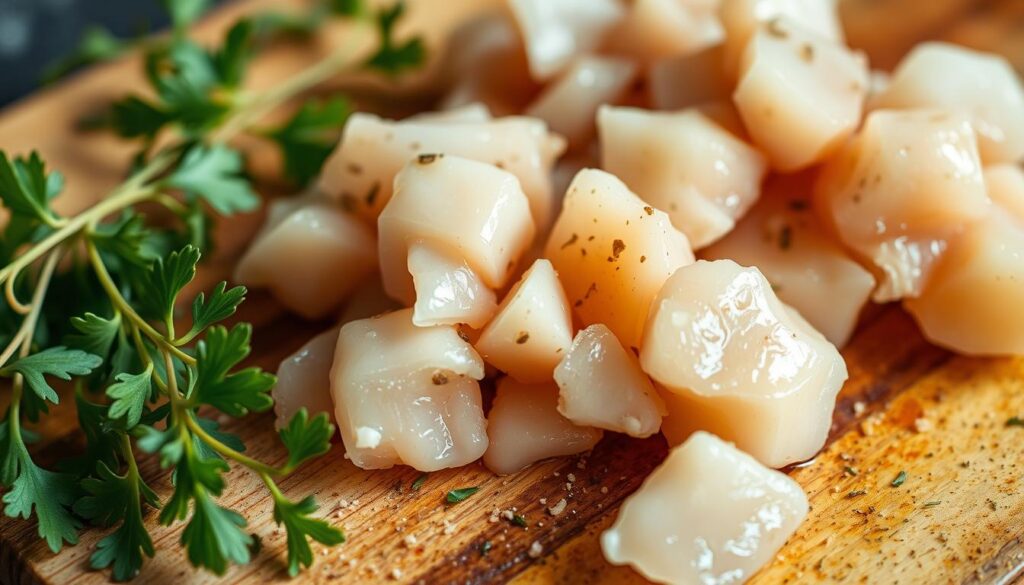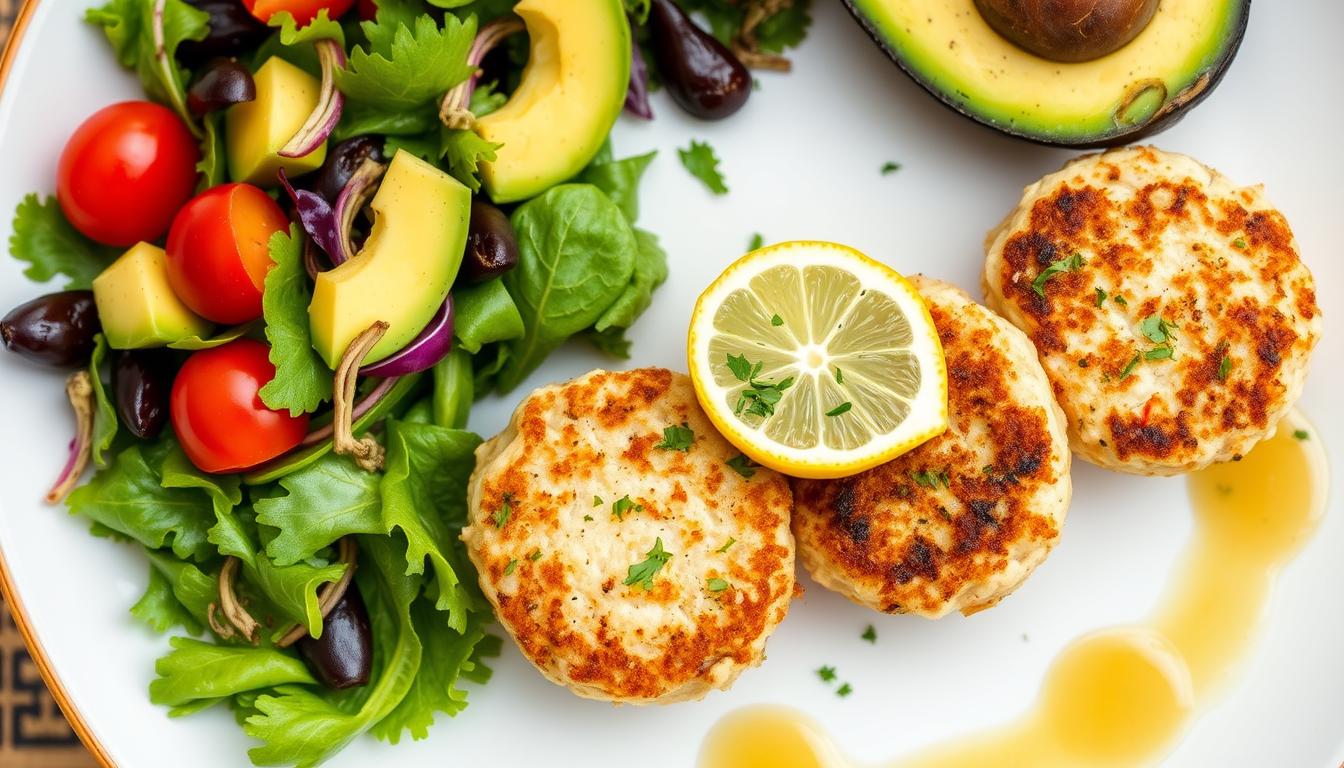Are you a seafood lover looking for a gluten-free option? This gluten-free crab cake recipe is perfect for you. It’s designed for those with dietary restrictions, offering rich, savory flavors without gluten. Whether it’s for a gathering or a special meal, this recipe will impress and satisfy your cravings.
Key Takeaways
- Discover the secrets to creating delicious gluten-free crab cakes at home
- Learn about the benefits of gluten-free cooking and safe seafood handling
- Explore alternative binding methods to achieve the perfect crab cake texture
- Understand the importance of ingredient selection and preparation techniques
- Discover complementary gluten-free sauces and serving suggestions
Understanding Gluten-Free Seafood Preparation
Are you into health-conscious cooking? You might be looking into gluten-free cooking for seafood dishes. It’s great for those who can’t eat gluten and opens up a world of flavors and healthier options.
Benefits of Gluten-Free Cooking
- It helps avoid digestive problems for those with gluten issues
- You get to use more fresh, nutrient-rich ingredients
- It lets you try new flavor and texture combos
- It might even help with inflammation and gut health
Safe Seafood Handling Tips
When making gluten-free seafood, food safety is key. Here are some tips to make sure your crab cakes are tasty and safe:
- Buy top-quality, fresh seafood from trusted places
- Clean all surfaces, tools, and hands well before and during cooking
- Keep food cold to stop bacteria from growing
- Cook seafood to the right temperature to kill germs
Essential Kitchen Tools
To make perfect gluten-free crab cakes, you’ll need some important tools:
- A sharp knife for cutting seafood
- Mixing bowls and spoons for mixing ingredients
- A nonstick pan or baking sheet for even cooking
- A spatula or tongs for handling crab cake patties

By knowing the benefits of gluten-free cooking, handling seafood safely, and having the right tools, you’re set to make tasty and healthy crab cakes. They’re perfect for a gluten-free diet.
Selecting the Perfect Crab Meat for Your Cakes
Choosing the right crab meat is key to making great gluten-free crab cakes. Lump crab meat is loved for its tender texture and sweet taste. It’s a favorite in Maryland-style crab cakes, offering a rich experience.
Not all crab meat is the same. In gluten-free cooking, picking the right type is crucial. Luckily, most crab meat types like lump, backfin, and jumbo lump are gluten-free. This makes them perfect for your gluten-free crab cake recipes.
| Crab Meat Type | Gluten-Free Status | Texture and Flavor |
|---|---|---|
| Lump Crab Meat | Gluten-Free | Large, succulent chunks with a sweet, delicate flavor |
| Backfin Crab Meat | Gluten-Free | Smaller flakes with a delicate, sweet taste |
| Jumbo Lump Crab Meat | Gluten-Free | Largest chunks with a rich, indulgent flavor |
When picking crab meat for your gluten-free crab cakes, think about what you like. Whether it’s jumbo lump, classic lump, or backfin, choose high-quality, gluten-free crab meat. It will make your Maryland-style crab cakes unforgettable.

Essential Ingredients for Gluten Free Crab Cake Recipe
Making gluten-free crab cakes is all about picking the right ingredients. The main ingredient is the crab meat. But, there are other key parts that make the dish tasty and complete.
Gluten-Free Binding Alternatives
Traditional crab cakes use breadcrumbs, but gluten-free ones need different binders. Good options are:
- Almond flour or almond meal
- Gluten-free panko breadcrumbs
- Cornmeal or polenta
- Quinoa flakes
These ingredients keep the crab cakes together while staying gluten-free.
Fresh Herbs and Seasonings
Herbs and spices are crucial for the flavor of gluten-free crab cakes. You’ll need:
- Finely chopped parsley
- Minced garlic
- Freshly ground black pepper
- A pinch of cayenne pepper or paprika for a touch of heat
These ingredients add great taste and aroma to the crab cakes.
Sauce Components
A good sauce is essential for gluten-free crab cakes. Choose creamy, tangy, or zesty sauces that match the crab’s flavor. Great options are:
- Gluten-free mayonnaise-based remoulade
- Lemon-garlic aioli
- Spicy Dijon mustard and lemon juice vinaigrette
These sauces make your gluten free crab cake recipe even better, without gluten.
Alternative Binding Methods Without Breadcrumbs
Gluten-free cooks face a challenge in making crab cakes stick together. But, there are many ways to keep them cohesive without losing flavor or texture.
Using gluten-free flour is a good option. Mix rice, tapioca, or almond flour for a strong yet soft crab cake. These flours not only bind but also add a nice, nutty taste that goes well with crab.
Egg is another effective binder. Beaten eggs help keep the crab meat together and prevent the cakes from falling apart. Adding a bit of mayonnaise or cream cheese to the eggs makes the crab cakes even creamier and more cohesive.
- Gluten-free flour blends (rice, tapioca, almond)
- Beaten eggs
- Mayonnaise or cream cheese
Choose your binding method wisely. Handle the crab meat gently and don’t over-mix. This way, you can make gluten-free crab cakes that are just as tasty and stick together as those with breadcrumbs.
“The key to perfect gluten-free crab cakes is finding the right balance of binders and flavors to create a cohesive, satisfying texture.”
Step-by-Step Mixing and Forming Technique
Making the perfect easy crab cake recipe is all about balance. You need to mix and form the ingredients just right. This is how you keep your crabcakes from falling apart.
Proper Mixing Methods
When mixing, gently fold the crab meat into the binding ingredients. Be careful not to overwork it. Overworking can make the crab meat break down, leading to dry cakes. Just mix until everything is combined lightly.
Shaping Perfect Patties
- Scoop the crab mixture into your hands and shape it into round patties, about 1/2 inch thick.
- Be gentle when handling the patties to avoid making them too dense.
- Try to make the cakes even and well-shaped so they hold up during cooking.
Chilling Requirements
After shaping, chill the crab cakes in the fridge for at least 30 minutes. This step lets the ingredients bind and helps the cakes keep their shape. Skipping this can make the cakes fall apart or lose their shape.
| Mixing Method | Shaping Patties | Chilling Time |
|---|---|---|
| Gentle folding | Uniform, round shape | At least 30 minutes |
By using these methods, you can make easy crab cake recipes that stay together. Learning how to mix and form is key to making delicious, crabcakes that won’t fall apart.
Cooking Methods: Baking vs. Pan-Frying
Preparing gluten free crab cakes can be a fun process. But, the cooking method you pick can change the taste and texture. You might ask: is it best to fry or bake crab cakes? Let’s look at the good and bad of each method.
Baking for a Healthier Approach
Baking your gluten free crab cake recipe is a smart choice for health. It skips the extra fat and calories of frying. Baked crab cakes are lighter and keep the crab meat tender.
Pan-Frying for a Crispy Exterior
But, pan-frying gives a crispy outside and a juicy inside. It adds richness and a golden color that many love.
Both baking and pan-frying can make tasty gluten free crab cakes. Just follow the recipe and adjust cooking time and temperature for the best results.
Choosing between baking or pan-frying depends on your taste and diet. Knowing the pros and cons helps you pick the right method. This way, you can enjoy gluten free crab cakes that you love.
Creating Complementary Gluten-Free Sauces
To take your dairy-free crab cakes to the next level, you need the right sauce. Gluten-free sauces can really bring out the flavors of seafood appetizers. We’ll look at two great options: a classic remoulade and a tangy citrus aioli.
Classic Remoulade
Remoulade is a French sauce that adds a nice zing to dairy-free crab cakes. Our gluten-free version has a creamy base with Dijon mustard, lemon juice, and herbs. Here’s what you need to make it:
- 1 cup mayonnaise
- 2 tablespoons Dijon mustard
- 1 tablespoon lemon juice
- 1 teaspoon paprika
- 1 teaspoon dried dill
- 1/2 teaspoon garlic powder
- Salt and pepper to taste
Citrus Aioli Option
For a bright and tangy sauce, try our citrus aioli. It’s made with garlic, lemon, and orange zest. This sauce is a refreshing match for your gluten-free crab cakes. Here’s how to make it:
- Combine 1 cup of mayonnaise with 2 cloves of minced garlic.
- Stir in the zest of 1 lemon and 1 orange.
- Add a squeeze of lemon juice to taste, along with salt and pepper.
Pair these sauces with your dairy-free crab cakes for a fantastic seafood meal.
Serving Suggestions and Pairings
When serving your gluten-free crab cakes, the options are vast! They can be the star of the show or a tasty starter. Pair them with various sides and drinks for a complete gluten-free meal.
For a light meal, place the crab cakes on a fresh green salad with tangy dressing. The salad’s crispness and zesty flavors will match the crab’s richness. For a heartier option, serve them with roasted veggies like asparagus or zucchini. This adds nutrients and keeps it gluten-free.
Here are some great additions to your crab cake feast:
- Lemon wedges to add a touch of acidity and brighten the flavors
- Crisp, gluten-free crackers or crostini for scooping up any extra sauce or remoulade
- A refreshing, gluten-free white wine or a light beer to balance the richness of the crab
Choosing the right sides and drinks can make your crab cake meal complete. It will please both your gluten-free guests and those who love healthy recipes.
Storage and Reheating Guidelines
Enjoying your gluten-free crab cakes doesn’t have to end when the meal is over. You can savor the flavors for days with proper storage and reheating.
Freezing Instructions
Leftover crab cakes or preparing them in advance? They freeze well. Place them in a single layer on a baking sheet and freeze until firm, about 2 hours. Then, put them in an airtight container or freezer-safe bag. They can last up to 3 months in the freezer.
Best Reheating Practices
Ready to enjoy your frozen gluten-free crab cakes? Here are a few methods to keep them delicious:
- For cooked crab cakes, preheat your oven to 400°F (200°C). Place them on a baking sheet and bake for 10-12 minutes, flipping halfway, until heated through.
- If they’re frozen uncooked, bake them directly from frozen. Increase the baking time to 15-18 minutes, flipping halfway, until cooked through.
- Alternatively, reheat them in a skillet over medium heat, about 3-4 minutes per side, until hot and crispy.
Choose any method, but watch them closely to prevent overcooking and keep their delicate texture.
Follow these simple storage and reheating tips to enjoy your crab cakes long after the first meal. Savor the flavors of your gluten-free crab cakes whenever you want!
Tips for Preventing Crab Cakes from Falling Apart
Getting the right texture in crab cakes is tricky. But, with the right methods, you can stop them from falling apart. Whether baking, pan-frying, or broiling, these tips will help keep them in shape.
Bind with Gluten-Free Alternatives
Crab cakes often fall apart because they lack a strong binder. Traditional breadcrumbs can be a problem for gluten-free cooks. But, there are great gluten-free substitutes. Try using cornmeal, almond flour, or even mashed potatoes to keep them together.
Chill Before Cooking
Chilling your crab cake mix in the fridge for 30 minutes to an hour helps a lot. This time lets the binders soak up moisture and firm up. This makes the cakes hold their shape better when cooked.
Handle Gently
When shaping and moving your crab cakes, be very gentle. Don’t squeeze or press them too hard. This can make them break. Instead, use a light touch and carefully place them with a spatula or your hands.
Cook at the Right Temperature
It’s important to cook at the right temperature. If it’s too hot, the outside will brown too fast while the inside stays soft. Cook at a moderate temperature to let the inside set right.
By using these tips, you can keep crabcakes from falling apart. Enjoy perfectly formed, tasty gluten-free crab cakes every time.
Conclusion
Gluten-free cooking is a world of delight, especially when making seafood dishes. Mastering gluten-free crab cake recipes lets you enjoy great taste while meeting dietary needs. The secret is choosing the right crab meat, using gluten-free binders, and mastering cooking techniques.
Whether you bake or pan-fry, this guide has you covered. It shows you how to make gluten-free crab cakes that wow everyone. Try new herbs, sauces, and sides to make your crab cakes even better.
Cooking is more than just making food. It’s about trying new things, enjoying the process, and sharing meals with loved ones. So, dive into the world of gluten free crab cake recipe, seafood recipes, and gluten-free cooking. Let your creativity shine and enjoy every bite.
FAQ
Do crab cakes contain gluten?
Yes, traditional crab cakes have gluten from ingredients like breadcrumbs or flour. But, you can make gluten-free crab cakes. Just use different binding agents instead of gluten.
What can you use instead of breadcrumbs in crab cakes?
You can use almond flour, panko-style gluten-free breadcrumbs, or crushed gluten-free crackers. These options help the crab cakes stick together without gluten.
Which crab meat is gluten-free?
Lump crab meat is naturally gluten-free. It comes from the crab’s body. Claw or backfin crab meat is also gluten-free if no gluten is added.
How do you keep crab cakes from falling apart?
Use the right binding agents and chill the cakes before cooking. Handle them gently while cooking. Chilling for at least 30 minutes helps them stay together.
Is it better to fry or bake crab cakes?
Both frying and baking make delicious gluten-free crab cakes. Frying gives a crispy exterior. Baking is healthier but still tasty. Choose based on what you prefer or need.


2 thoughts on “Gluten-Free Crab Cake Recipe for Seafood Lovers”